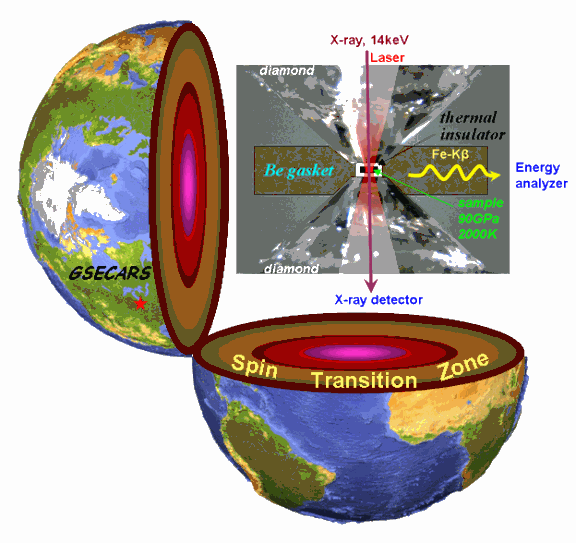A spin transition zone (STZ) in Earth’s lower mantle that differs significantly from previously known structural transitions in the deep Earth has been detected by researchers using high-pressure-temperature facilities at the GSECARS beamline on sector 13 of the Argonne Advanced Photon Source. Their results are published in Science magazine.
The researchers, from Lawrence Livermore National Laboratory, the University of Chicago, KFKI Research Institute for Particle and Nuclear Physics in Hungary, the European Synchrotron Radiation Facility in France, Northwestern University, the Carnegie Institution of Washington, and Washington State University, have looked at the electronic spin state of iron in a mineral called ferropericlase, an iron-magnesium oxide [(Mg0.75,Fe0.25)O], at high temperatures and pressures relevant to the conditions of the Earth’s lower mantle. For the first time, they were able to track down exactly where the spin transition occurs in the lower mantle. Their observation showed that an electronic spin transition of iron occurs continuously over extended pressure-temperature conditions relevant to the middle part of the Earth’s lower mantle.
“The Earth’s interior, as we know it, is separated into a few layers-, crust, mantle, and core-, which are well defined by their crystal structures and compositions. For example, the Earth’s lower mantle, which makes up more than half of the Earth by volume, is made mostly of ferropericlase (an iron-magnesium oxide) and silicate perovskite (an iron-magnesium silicate), which are very different in compositions and structures from the underlying metallic core comprising mainly iron, and overlying crust,” explained Jung-Fu Lin (Lawrence Livermore National Laboratory), the lead author of the Science paper.
To detect the spin transition zone of iron in the lower-mantle minerals, the scientists at GSECARS have built a benchmark system that employs the x-ray emission spectroscopy technique based on a Rowland circle spectrometer combined with x-ray diffraction and double-sided laser-heating techniques. “In this very challenging experiment we precisely aligned a small sample (usually sized down to 12 microns in thickness and 70 microns in diameter) with six optical axes: x-ray beam, emission spectrometer, down-stream and up-stream laser beams, and two optical paths for temperature measurements. The state-of-the-art system here allowed us to probe the electronic spin states of iron in the lower-mantle minerals in situ at high pressure-temperature conditions generated in a sample chamber of a diamond anvil cell,” said Vitali Prakapenka (a senior research associate at University of Chicago/GSECARS).
The STZ concept differs from previously known structural transitions in the Earth’s interior (e.g., transition zone), because the STZ is defined by the electronic spin transition of iron in mantle minerals from the high-spin to the low-spin states. “By directly observing the spin transition of iron under lower mantle conditions, we now know that the spin transition zone needs to be considered in future models of the lower mantle, because the spin states of iron are known to affect the physical properties of the lower-mantle minerals. These effects across the spin transition zone in turn affect our understanding of the speeds of the seismic waves, compositions, and dynamics of the lower mantle,” explained Alexei Kuznetsov (a research associate at University of Chicago/GSECARS).
The researchers believe that the newly observed spin transition zone will stimulate a deep-Earth-science community effort to develop a more satisfactory model of the seismic, mineralogical, and geodynamic behavior of the lower mantle, because in the past, geophysicists had neglected the effects of the spin transition when studying the Earth’s interior. This research also calls for future seismic and geodynamic tests in order to understand the properties of the spin transition zone.
Contact: Jung-Fu Lin ([email protected]),
Vitali Prakapenka ([email protected]),
Alexei Kuznetsov ([email protected])
See: Jung-Fu Lin, György Vankó, Steven D. Jacobsen, Valentin Iota, Viktor V. Struzhkin, Vitali B. Prakapenka, Alexei Kuznetsov, Choong-Shik Yoo, “Spin Transition Zone in Earth’s Lower Mantle,” Science, 317(5845), 1740 (2007). DOI: 10.1126/science.1144997
This work performed at GeoSoilEnviroCARS is supported by the National Science Foundation - Earth Sciences (EAR-0622171) and Department of Energy - Geosciences (DE-FG02-94ER14466). Use of the Advanced Photon Source was supported by the U. S. Department of Energy, Office of Science, Office of Basic Energy Sciences, under Contract No. DE-AC02-06CH11357. The work at LLNL was performed under the auspices of the U.S. DOE by the University of California and LLNL under Contract No. W-7405-Eng-48.
Argonne is a U.S. Department of Energy laboratory managed by UChicago Argonne, LLC

